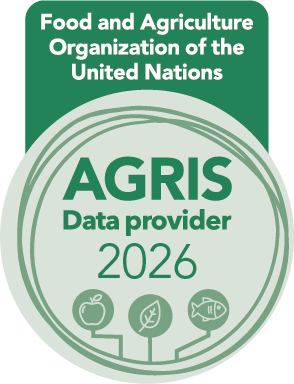Unraveling the impact of soil nutrients on papaya black spot disease caused byAsperisporium caricae (Speg.) Maubl
DOI:
https://doi.org/10.24154/jhs.v20i1.2480Keywords:
Available nitrogen, correlation, disease severity, exchangeable magnesium, soilAbstract
The study was conducted to correlate soil nutrient factors and papaya black spot disease severity on leaves and fruits of the papaya plant cv. Taiwan Red Lady. The results revealed that there was a positive correlation coefficient i.e. increase in black spot severity) for soil pH, available nitrogen, available phosphorus, exchangeable calcium and magnesium and hot water extractable boron with black spot of leaf severities, whereas, electrical conductivity, organic carbon, available potassium, available sulfur, DTPA extractable zinc, DTPA extractable manganese, iron and copper were negatively correlated with black spot severity on leaves. Further, black spot severity on fruits were positively correlated with soil pH, available N, available P, exchangeable Ca and Mg, DTPA extractable Cu, and negatively correlated with EC, OC, available K and S, DTPA extractable Zn, Mn and Fe, and hot water extractable B. Hence, the available nitrogen and exchangeable magnesium concentrations in soil significantly influence the papaya black spot disease severity but the difference in black spot severity due to changes in the concentration of nutrients other than these two analyzed in the experiment was nonsignificant.
Downloads
References
Bavaresco, L., & Eibach, R. (1987). Investigations on the influence of nitrogen fertilizer on resistance to powdery mildew (Oidium tuckeri), downy mildew (Plasmopara viticola), and on phytoalexin synthesis in different grape varieties. Vitis, 26, 192–200.
Bennett, M. D., & Leitch, I. J. (2005). Plant DNA C-values database (Release 4.0, October 2005).
Dong, X., Wang, M., & Ling, N. (2016). Effects of iron and boron combinations on the suppression of Fusarium wilt in banana. Scientific Reports, 6, 38944. https://doi.org/10.1038/srep38944
Ellis, M. B., & Holliday, P. (1972). Asperisporium caricae (CMI descriptions of pathogenic fungi and bacteria No. 347, pp. 1–2).
Filippi, M. C., & Prabhu, A. S. (2014). Relationship between panicle blast severity and mineral nutrient content of plant tissue in upland rice. Journal of Plant Nutrition, 21(8), 1577–1587. https://doi.org/10.1080/01904169809365505
Garibaldi, A., Gilardi, G., Cogliati, E. E., & Gullino, M. L. (2012). Silicon and increased electrical conductivity reduce downy mildew of soilless grown lettuce. European Journal of Plant Pathology, 132, 123–132.
Graham, D. R. (1983). Effects of nutrient stress on susceptibility of plants to disease with particular reference to the trace elements. In J. A. Callow (Ed.), Advances in botanical research (Vol. 10, pp. 221–276). Academic Press. https://doi.org/10.1016/S0065-2296(08)60261-X
Huber, D. M. (1980). The role of mineral nutrition in defense. In J. G. Horsfall & E. B. Cowling (Eds.), Plant disease: An advanced treatise. How plants defend themselves (Vol. 5, pp. 381–406). Academic Press.
Jackson, M. L. (1973). Soil chemical analysis. Prentice Hall of India Pvt. Ltd.
Keane, E. M., & Sackston, W. E. (1970). Effects of boron and calcium nutrition of flax on Fusarium wilt. Canadian Journal of Plant Science, 50, 415–422. https://doi.org/10.4141/cjps70-076
Lindsay, W. L., & Norvell, W. A. (1978). Development of a DTPA soil test for zinc, iron, manganese, and copper. Soil Science Society of America Journal, 42(3), 421–428.
Mayee, C. D., & Datar, V. V. (1986). Phytopathometry (Technical Bulletin 1, Special Bulletin 3). Marathwada Agricultural University, Parbhani.
Ministry of Agriculture and Farmers Welfare. (2021). National horticulture board statistics 2020–21. Government of India.
Olesen, J. E., Jørgensen, L. N., Petersen, J., & Mortensen, J. V. (2003). Effects of rate and timing of nitrogen fertilizer on disease control by fungicides in winter wheat. The Journal of Agricultural Science, 140(1), 1–13. https://doi.org/10.1017/S0021859602002885
Patel, P. S., Sanath Kumar, V. B., Kiran Kumar, N., Chandrappa, & Palanna, K. B. (2024). The impact of bioagents’ cultural filtrate on the postharvest management of disease caused by Asperisporium caricae (Speg.) Maubl. International Journal of Advanced Biochemistry Research, 8(6), 472–476. https://doi.org/10.33545/26174693.2024.v8.i6f.1351
Piper, C. S. (1966). Soil and plant analysis. Hans Publishers.
Rajukumar, Ansari, M. N., Kumar, N., & Kumar, B. (2018). Constraints perceived by the papaya growers in adoption of improved papaya production technology in Begusarai district of Bihar, India. International Journal of Current Microbiology and Applied Sciences, Special Issue 7, 2590–2595.
Santos, M. C., & Barreto, M. (2003). Epidemiological study of papaya smallpox in cultivars submitted to fungicide treatment. Phytopathology, 29, 141–146.
Sharma, R. C., & Duveiller, E. (2004). Effect of Helminthosporium leaf blight on performance of timely and late-seeded wheat under optimal and stressed levels of soil fertility and moisture. Field Crops Research, 89(2–3), 205–218. https://doi.org/10.1016/j.fcr.2004.02.002
Sparks, D. L., Bartels, J. M., & Bigham, J. M. (1996). Methods of soil analysis: Part 3. Chemical methods. Soil Science Society of America.
Storey, W. B., Bergh, B., & Zentmyer, G. A. (1986). The origin, indigenous range and dissemination of the avocado. California Avocado Society Yearbook, 70, 127–133.
Subbaiah, B. V., & Asija, G. L. (1956). A rapid procedure for the estimation of available nitrogen in soils. Current Science, 25, 259.
Wheeler, B. E. J. (1969). An introduction to plant diseases. John Wiley & Sons.
Workneh, F., Van Bruggen, A. H. C., Drinkwater, L., & Shennan, C. (1993). Variables associated with corky root and Phytophthora rot of tomatoes in organic and conventional farms. Phytopathology, 83(6), 581–588.
Downloads
Published
Issue
Section
License
Copyright (c) 2025 Y Swathi Shetty, V B Sanath Kumar, N Kiran Kumar, K R Ashoka, Pooja Patel (Author)

This work is licensed under a Creative Commons Attribution-NonCommercial-ShareAlike 4.0 International License.
Authors retain copyright. Articles published are made available as open access articles, distributed under the terms of the Creative Commons Attribution-NonCommercial-ShareAlike 4.0 International License, which permits unrestricted non-commercial use, distribution, and reproduction in any medium, provided the original author and source are credited. 
This journal permits and encourages authors to share their submitted versions (preprints), accepted versions (postprints) and/or published versions (publisher versions) freely under the CC BY-NC-SA 4.0 license while providing bibliographic details that credit, if applicable.







 .
. 











